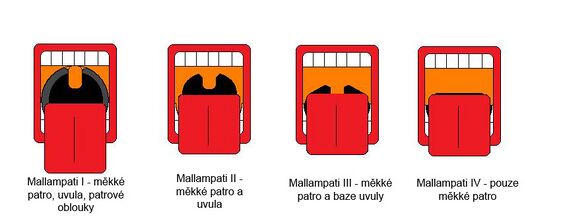Difficult intubation
From WikiLectures
Definition[edit | edit source]
- A condition where we need more than three attempts for routine laryngoscopy and intubation or it takes more than 10 minutes.
- Difficult laryngoscopy: if the structures of the larynx visible during ordinary laryngoscopy are not visible or identifiable.
- Incidence approximately 0.5-5%.
- Evaluation using the Cormack and Lehane (1984) score of values I–IV
- Cormack I – vocal cords are clearly visible;
- Cormack II – only posterior edge of glottis visible;
- Cormack III – only epiglottis visible;
- Cormack IV – only soft palate visible (epiglottis not visible).
When can we expect difficult intubation?[edit | edit source]
Difficult intubation is expected in patients with the following diagnoses and anatomical conditions:
- Pregnancy,
- limited mobility of the cervical spine (e.g. Morbus Bechtěrev, limited mobility of the cervical spine ),
- monstrous goiter, elongated trachea,
- overbite or promining incisors,
- epiglottitis,
- macroglossia and acromegaly,
- small oral cavity (under 2 cm when maximally open),
- anatomical variants, tumors in the neck area, injuries to the neck and face,
- conditions after irradiation of the larynx,
- burns.
- Clinical assessment of difficult intubation during preoperative examination
- Thorough anamnesis - focused on diseases or traumas in the neck and cervical spine and ENT area.
- Previous successful or failed intubations in previous surgeries.
- Evaluation according to Mallampati: aspect of the oral cavity and visibility of individual structures. Well visible are:
- soft palate, back wall of the pharynx, uvula, anterior and posterior palatine arch;
- soft palate, back wall of the pharynx, uvula;
- soft palate, base of uvula;
- soft palate only difficult to see.
Procedure for difficult intubation[edit | edit source]
If intubation is expected to be difficult we can perform elective fiberscopic intubation while conscious, or if the expected risk is lower, we can primarily prepare a video laryngoscope or other aids.
In case of unexpectedly difficult intubation, we can use the following procedures:
- A maximum of two to three attempts – positioning the patient's head, using different laryngoscopic spoons, using a tube guide (buje), pressure on the thyroid cartilage (Sellick's maneuver). We should change something every time we try.
- If we do not intubate the patient after three attempts, we continue to ventilate and call for the help of a more experienced colleague in time.
- Avideolaryngoscope can be used for intubation.
- If even a colleague fails, we will try to introduce a laryngeal mask or other device to secure the airways (we will assess whether it is appropriate to conduct the entire anesthesia with the pathways secured in this way; if so, we continue further, if not, we take the patient out of anesthesia).
- It is also possible to try to insert an intubation cannula through the supraglottic device, either directly or with the help of a fiberscope.
- Air ducts can be used when mask ventilation is difficult.
- Can ventilate, can’t intubate if you can breathe with a mask, but you can't intubate, although it is necessary and the operation is urgent, we have to intubate with a flexible bronchoscope.
 is an acute life-threatening condition, we cannot intubate the patient or ventilate with a mask (attempts to intubate and insert a laryngeal mask failed, the patient cannot be breathed even with a mask), we immediately call the team to perform a tracheotomy, or perform coniopuncture.
is an acute life-threatening condition, we cannot intubate the patient or ventilate with a mask (attempts to intubate and insert a laryngeal mask failed, the patient cannot be breathed even with a mask), we immediately call the team to perform a tracheotomy, or perform coniopuncture.
Links[edit | edit source]
[edit | edit source]
External links[edit | edit source]
- Difficult airway management – interactive algorithm + test
- Management of unexpected difficult intubation
- Predikce obtížného zajištění dýchacích cest, možnosti a algoritmy – LF MU, Akutně.cz
References[edit | edit source]
- KRETZ, Franz-Josef – TEUFEL, Frank. Anästhesie und Intensivmedizin. 1. edition. Heidelberg : Springer, 2006. 695 pp. ISBN 3-540-62739-1.
- HECK, Michael – FRESENIUS, Michael. Repetitorium Anästhesiologie. 5. edition. Heidelberg : Springer, 2007. 642 pp. ISBN 978-3-540-46575-1.



